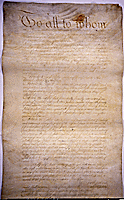The Articles of Confederation
Because of the fear that resulted from the colonial experience under the centralized government of Great Britain, the committee had been careful to give the states as much independence as possible, while also explicitly stating the limited functions of the federal government. Yet, several years would pass and many revisions would occur before the Articles were finally adopted. The delay was the result of such factors of preoccupation with the Revolutionary War and disagreements among the 13 states. These disagreements were over such things as boundary lines and the conflicting decisions reached by the courts of the different states. The smaller states wanted equal representation in Congress with the larger states. The states that had larger populations did not want to pay an extensive amount of money to the federal government if taxation was based upon population. There was also wide disagreement over who would control the western territories. The states that did not have frontier borders wanted the government to control the sale of these lands so that all states could benefit. States with frontier borders, conversely, wanted to control as much of the territory land as they could, in the hopes of expanding their borders or reaping a profit from its sale. After much discussion and compromise, the Articles of Confederation were adopted by the Congress on November 15, 1777. The Articles were comprised of a preamble and 13 articles. The document maintained the aspect of voting done by states and taxes were based upon the value of buildings and land and not by a state’s population. The Articles also specified that no state could be deprived of territory for the benefit of the country and that all 13 states had to agree to any amendment of the federal government’s power. The Articles of Confederation became the ruling document in the new nation after they were ratified by the last of the 13 American states, Maryland, in 1781. The Articles created a nation that was "a league of friendship and perpetual union." The state governments retained most of the power under this framework, with a subordinate position given to the central government. The central government commanded little respect and was not able to accomplish much because it had little jurisdiction over states or individuals. The following are the major challenges to governing through the Articles of Confederation.
In the words of George Washington, the government created by the Articles of the Confederation was "little more than the shadow without the substance." As the need for a stronger federal government began to be realized, leaders from throughout the states got together to decide how to create it. The Federal Constitutional Convention of 1787 was responsible for drafting the Constitution of the United States, the document which took the place of the Articles of Confederation in 1787.
|


